Essay on the Menace of Hijacking – In the early seventies an aeroplane was hijacked for the first time. That was the work of Popular Front for the Liberation of Palestine.
Since then airport authorities have become conscious of the menace throughout the world and have taken various precautionary measures to prevent repetition of the incident.
Yet hijackings have continued; initially connected mostly with the Arab-Israeli dispute and mainly aimed at citizens of America and its western allies. But for them, the Arabs believe, an independent and sovereign Jewish state would not have come into being in West Asia.
ADVERTISEMENTS:
There were other hijackings as well, unrelated to Palestine or Israel. A couple of examples: twice Indian Airlines flights were forced to land in Pakistan by hijackers. A young mainland Chinese hijacked a British Airways plane to Taiwan.
In each case no passenger was hurt and the planes were not damaged. Incidents in West Asia, on the other hand, seldom ended without tragedy. Every time the airlines and airport authorities took new preventive steps-like body search, electronic scanning and X-ray surveillance of boarding passengers — the hijackers came out with new ways to hoodwink security.
At times even some signatories to the Geneva Convention, pledged not to accord sanctuary to hijackers, were constrained to refuse to implement the pledges. In many cases, the hijackers blew up planes and tortured passengers and crew members.
ADVERTISEMENTS:
The points to ponder are how to make air journeys safe and how to protect the passengers of a certain country quite unconcerned with politics of any kind and travelling from one place to another for business or pleasure from being captured and tortured simply because they have a government with which the hijackers are at loggerheads.
Another question is how to curb at this point a method of blackmailing legitimate authority used increasingly by groups of dissidents, rebels, hostiles, outlaws, fanatic religious leaders and others.
